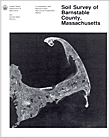The following is a map unit description from the "Soil Survey of Barnstable County, Massachusetts (Fletcher, 1993)"

DeA-Deerfield loamy fine sand, 0 to 5 percent slopes. This very deep, nearly level and gently sloping, moderately well drained soil is in depressions, swales, and low areas adjacent to streams and ponds. It is on outwash plains and in areas of glacial lake deposits. It makes up about 0.4 percent (1,116 acres) of the survey area. It is mapped throughout the county. Areas are irregular in shape and range from 5 to 30 acres in size.
Typically, the surface is covered with an organic layer. This layer is about 2 inches of loose, undecomposed leaves and twigs and 1 inch of partly decomposed and well decomposed organic material. The surface layer is friable loamy fine sand about 10 inches thick. The upper 1 inch is dark gray, and the lower 9 inches is dark brown. The subsoil is about 19 inches thick. The upper 14 inches is yellowish brown, loose fine sand, and the lower 5 inches is light yellowish brown, mottled, loose sand. The substratum to a depth of 65 inches or more is light olive brown, mottled, stratified, loose sand and gravel.
Included with this soil in mapping are small areas of Amostown, Carver, Eastchop, Pipestone, and Sudbury soils. These soils make up about 20 percent of this unit.
Permeability is rapid in the subsoil of the Deerfield soil and rapid or very rapid in the substratum. Available water capacity is low. Depth to the seasonal high water table is 1.5 to 3.0 feet in winter and early spring.
Most areas are used as woodland. Some areas are used as cropland, and a few areas have been developed for homesites.
This soil is suited to cultivated crops. The seasonal high water table and the low available water capacity are management concerns. The seasonal high water table commonly keeps the soil wet in early spring and delays farming activities. Irrigation is generally needed for the optimum growth of most cultivated crops during dry periods. Mixing crop residue and manure into the surface layer helps to maintain good tilth and increases the available water capacity. Establishing diversions, growing cover crops, stripcropping, and farming across the slope or on the contour reduce the risk of erosion in gently sloping areas.
This soil is suited to hay and pasture. The main management objective is the prevention of overgrazing, which reduces the hardiness and density of desirable plants and exposes the soil to erosion. Proper stocking rates, timely grazing, and restricted use during wet periods help to maintain plant density and minimize surface compaction.
This soil is fairly well suited to woodland. Seedling mortality is moderate because of the droughtiness. Minimizing surface disturbance helps to retain a spongelike mulch of leaves, which absorb precipitation. Designing regeneration cuts to optimize shade and reduce the rate of evapotranspiration helps to maintain the limited moisture supply. The most common trees are white oak, pitch pine, scarlet oak, and red maple.
The seasonal high water table is a limitation if this soil is used as a site for dwellings with or without basements or as a site for septic tank absorption fields. Additions of fill and a regional drainage system help to overcome the wetness. Because of the rapid or very rapid permeability in the substratum, the soil may not adequately filter the effluent in septic tank absorption fields. The poor filtering capacity may result in the pollution of ground water. The hazard of pollution increases with the density of housing.